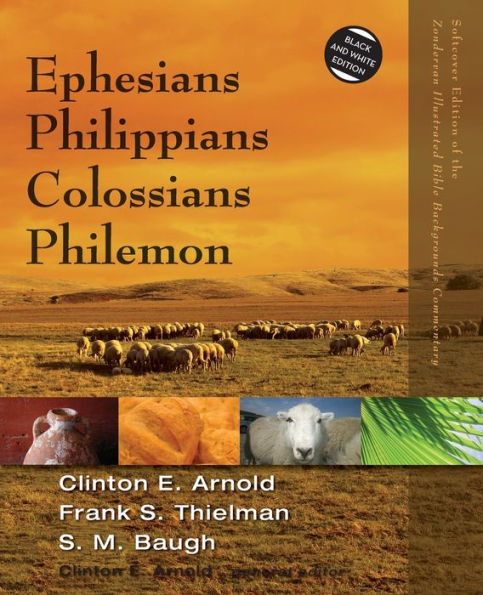
Ephesians, Philippians, Colossians, Philemon
144
Ephesians, Philippians, Colossians, Philemon
144Paperback
-
PICK UP IN STORECheck Availability at Nearby Stores
Available within 2 business hours
Related collections and offers
Overview

Product Details
| ISBN-13: | 9780310523055 |
|---|---|
| Publisher: | Zondervan Academic |
| Publication date: | 06/16/2015 |
| Series: | Zondervan Illustrated Bible Backgrounds Commentary |
| Pages: | 144 |
| Sales rank: | 1,172,520 |
| Product dimensions: | 7.40(w) x 9.20(h) x 0.30(d) |
About the Author
Frank Thielman (Ph D, Duke University) is Presbyterian professor of divinity at Beeson Divinity School, Samford University, in Birmingham, Alabama. He is the author of Philippians in the NIV Application Commentary series.
S. M. Baugh (Ph D, University of California, Irvine) is professor of New Testament at Westminster Seminary in Escondido, California.
Clinton E. Arnold (Ph D, University of Aberdeen) is research professor of New Testament at Talbot School of Theology, Biola University in La Mirada, California. He has authored many books and commentaries, including Ephesians in the Zondervan Exegetical Commentary series and Acts in the Zondervan Illustrated Bible Backgrounds Commentary.
Read an Excerpt
Ephesians, Philippians, Colossians, Philemon
Zondervan
Copyright © 2002 Clinton E. ArnoldAll right reserved.
ISBN: 978-0-310-27827-6
Chapter One
Ephesus and Western Asia Minor
The city of Ephesus was the leading city of the richest region of the Roman empire. With a population of about 250,000 people, only Rome and Alexandria were larger. Ephesus served as the Roman provincial capital of Asia Minor and was a prosperous commercial center. As the principal port for Asia Minor, merchant and cargo vessels from all over the Mediterranean docked there to unload passengers and goods as well as to transport products from Asia Minor to Rome and throughout the empire. The first-century writer Strabo called Ephesus "the greatest commercial center in Asia this side of the Taurus river."
The city was cosmopolitan and multiethnic. In addition to the indigenous Anatolian peoples of Ionia, Lydia, Phrygia, Caria, and Mysia, Ephesus was home to Egyptian, Greek, and Roman settlers. There was also a strong Jewish community in the city since Seleucid times (3d century B.C.). It appears that the Jews of the city had a fairly cordial relationship with the civic officials and the local populace since there is no evidence of the kind of ethnic strife that rocked Alexandria and Rome. According to Josephus, they had been granted freedom to practice their religion according to their own traditions.
The Introduction ofChristianity to the City
Paul started the church at Ephesus after his eighteen-month sojourn in Corinth and following a visit to Jerusalem. He was aided significantly by the help of a Jewish-Christian couple from Rome, Priscilla and Aquila.
Luke provides us with a few of the highlights of Paul's ministry there in Acts 19. Following the typical pattern of his missionary outreach, Paul began proclaiming the gospel in the synagogue until opposition to his preaching grew too strong. He then moved to a lecture hall in the city where he taught regularly. The Western text of the book of Acts preserves the tradition that he taught there daily between 11:00 A.M. and 4:00 P.M. Most significantly, Luke claims that not only did people in Ephesus and its environs hear the gospel during these two years, but "all the Jews and Greeks who lived in the province of Asia heard the word of the Lord" (Acts 19:10). It was during this time that churches began in various other cities of western Asia Minor including Colosse, Laodicea, Pergamum, Smyrna, Sardis, Magnesia, Tralles, and elsewhere.
The original church of Ephesus thus consisted of many converted Jews and Gentile God-fearers and sympathizers to the Jewish faith, as well as many Gentiles coming directly from the pagan cults of the city, particularly the cult of Artemis. If the silversmith guild had experienced such a sharp decline of revenues for their images of Artemis, there was probably a sizeable group of Gentiles who embraced the one true God and the Lord Jesus Christ.
It is highly unlikely that the church met as a large group in one central location. Groups of believers probably met in homes every Lord's day in various parts of the city and in the local villages (e.g., Hypaipa, Diashieron, Neikaia, and Koloe).
The Spiritual Climate of the Area
There are some distinctive features of the religious environment of the area that help us better understand the discipleship issues these new believers faced and why Paul addressed certain topics and stressed others in his letter.
* Ephesians IMPORTANT FACTS:
AUTHOR: The apostle Paul.
DATE: A.D. 60-61 (Paul imprisoned in Rome).
OCCASION:
To give new believers converted from a background in Judaism, local religions, magic, and astrology a positive grounding in the gospel of Christ.
To help and admonish believers to cultivate a distinctively Christian lifestyle.
KEY THEMES:
1. Christ is supreme over all of creation, especially the powers of darkness.
2. Believers participate with Christ in his death, resurrection, and fullness.
3. The church is the one body of Christ and is composed of Jews and Gentiles.
(Continues...)
Excerpted from Ephesians, Philippians, Colossians, Philemon Copyright © 2002 by Clinton E. Arnold. Excerpted by permission.
All rights reserved. No part of this excerpt may be reproduced or reprinted without permission in writing from the publisher.
Excerpts are provided by Dial-A-Book Inc. solely for the personal use of visitors to this web site.
Table of Contents
Contents
Introduction......................................viList of Sidebars..................................viii
List of Charts....................................ix
Index of Photos and Maps..........................x
Abbreviations.....................................xii
Ephesians Clinton E. Arnold......................2
Philippians Frank Thielman.......................44
Colossians Clinton E. Arnold.....................72
Philemon S. M. Baugh.............................106
Credits for Photos and Maps.......................114
